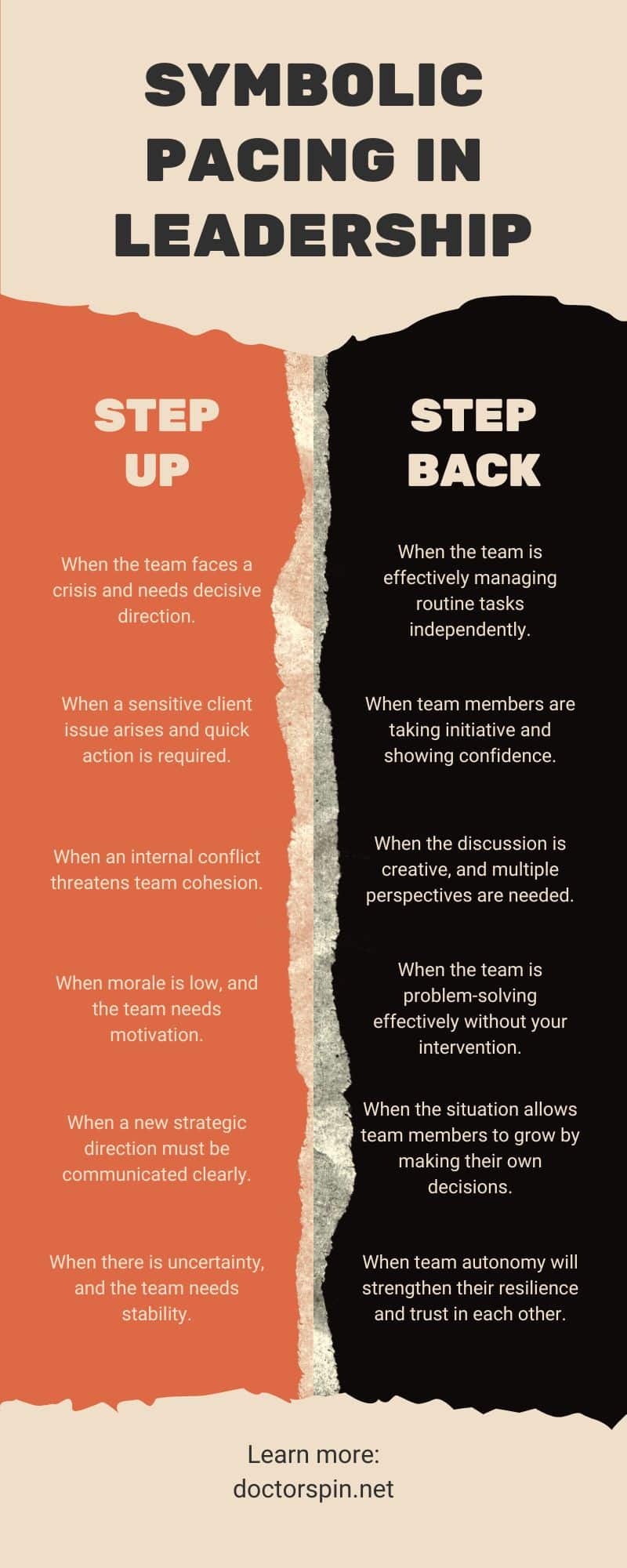Practice symbolic pacing in your communicative leadership.
Effective leadership isn’t synonymous with constant action or relentless involvement:
A powerful but often overlooked approach is to practice symbolic pacing — knowing when to step back and let your team take the lead and when to step up and provide direct guidance, especially in times of heightened sensitivity or crisis.
Leadership pacing is about managing your energy and ensuring you’re ready to lead actively when the situation demands it.
Here we go:
Symbolic Pacing in Communicative Leadership
In day-to-day operations, stepping back and allowing your team to problem-solve and take initiative is critical:
When everything runs smoothly, your team benefits from the autonomy to address challenges independently, fostering their confidence and resilience. The leader’s role during these moments is to rest and observe — a purposeful rest that enables you to stay fresh and ready to take a more active stance when required.
However, there are moments when symbolic pacing requires you to step up decisively. In sensitive situations or during crises, your visible initiative becomes a stabilising force for your team.
By stepping in assertively, you demonstrate leadership when it’s most needed, providing direction and focus during uncertain times. Your presence in these moments of intensity builds trust and ensures your team knows they can rely on you when the stakes are high.
Symbolic pacing is about creating an atmosphere where your team feels empowered during stable times (i.e. the leader steps back) and supported during turbulent times (i.e. the leader steps up).
This balance between stepping back and stepping up is not arbitrary. According to Hackman and Wageman (2005), effective leadership often involves knowing when to shift roles — adapting between active intervention and more passive oversight. This type of flexibility is essential to maintaining a dynamic and resilient team structure. 1Hackman, J. R., & Wageman, R. (2005). A theory of team coaching. Academy of Management Review, 30(2), 269 – 287. https://doi.org/10.5465/amr.2005.16387885
Stepping Up, Stepping Back (Infographic)
Balancing Your Leadership
The leader’s ability to pace themselves — to rest when possible and intervene when necessary — enables a sustainable and effective leadership model.
Research by Weick and Sutcliffe (2007) also supports this idea by highlighting the value of mindfulness in leadership. Mindful leaders can better judge when to engage actively and when to allow their teams the space to operate independently. This mindfulness contributes to a culture of reliability within the team — team members are confident that their leader is attentive and responsive, capable of taking control when needed, yet respectful of the team’s autonomy daily. 2Weick, K. E., & Sutcliffe, K. M. (2007). Managing the unexpected: Resilient performance in an age of uncertainty (2nd ed.). Jossey-Bass.
The act of stepping back signals trust, while stepping forward signals support. This dual signal is crucial for maintaining morale and productivity across different circumstances.
Pacing as a Symbol of Readiness
Leadership is not about being everywhere all the time. It is about being present where and when it counts the most and letting your team shine whenever possible.
Seeing the leader take the initiative in a challenging situation also has substantial symbolic value: it reassures the team that their leader is ready to step up when things get rough.
The leader’s visible readiness reinforces trust and builds confidence within the team, knowing they have strong leadership that will rise to the challenge when it truly matters.
By employing symbolic pacing, you maintain your leadership energy, empower your team, and create a resilient organization that thrives under routine and pressure.
To put this into practice, consider a rhythm to your leadership actions. Encourage your team to lead discussions, initiatives, and solutions during routine operations.
Watch for sensitive inflexion points — perhaps a challenging client situation or an internal conflict — and then step forward decisively.

THANKS FOR READING.
Need PR help? Hire me here.

What should you study next?
Spin Academy | Online PR Courses

Spin’s PR School: Free Leadership PR Course
Take advantage of this Free Leadership PR Course to sharpen your public relations skills and become a confident and influential leader in any industry.
Leadership Theory
Communicative Leadership
Bonus Articles
Learn more: All Free PR Courses
💡 Subscribe and get a free ebook on how to get better PR.

Annotations
| 1 | Hackman, J. R., & Wageman, R. (2005). A theory of team coaching. Academy of Management Review, 30(2), 269 – 287. https://doi.org/10.5465/amr.2005.16387885 |
|---|---|
| 2 | Weick, K. E., & Sutcliffe, K. M. (2007). Managing the unexpected: Resilient performance in an age of uncertainty (2nd ed.). Jossey-Bass. |



